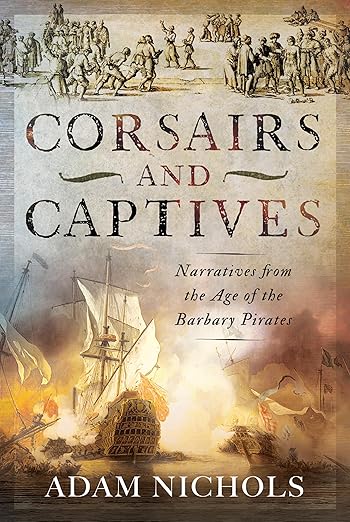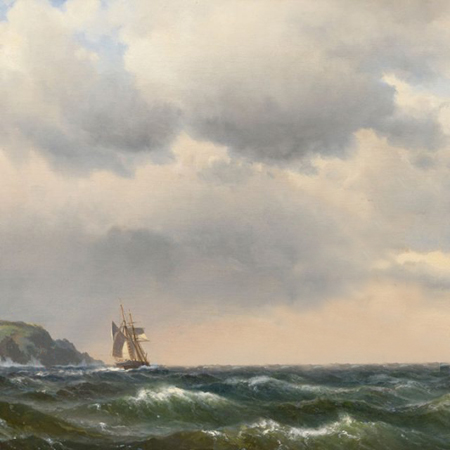Last week, we took a slight detour from the series of posts that tell the story of Helgi Jónsson, the young Icelander captured in the summer of 1627 by Barbary corsairs. Helgi, remember, wound up enslaved in Algiers to a Bölükbaşı (a janissary captain). He was not by any means the only person to have this happen to him. The same thing happened to René du Chastelet des Boys—who was forced to serve aboard corsair ships a decade or so after Helgi.
Des Boys published a narrative in which he described his experience. Last week we began that narrative. This week, we continue it.
Keep in mind as you read that des Boys’ story is his own, but that it also depicts the sorts of experiences endured by Helgi Jónsson and other enslaved captives like him (there were many) who found themselves forced to serve aboard Barbary corsair ships.
We pick up the story as des Boys and his master, the Ouda Bachi Topeclaure embark on a corsair ship.
The day of our departure dawned, and a brisk wind from the land moved us quickly away from the port. Algiers diminished visibly… and finally disappeared. The coast of Barbary dwindled behind us. And so we began our expedition, on a sea that seemed like a giant, unpolished emerald, still turmoiled by a recent storm.
Joseph Reis [the Kouloughli Captain] was superstitious, and in order to make preparation for a successful hunt, he called into his cabin the ship’s cleric and all the other notables on board, including my master, the Ouda Bachi. I, however, was banished, along with the other slaves, to the depths of the ship’s hold. I only learned the next day, from a Sicilian renegado, the secret and the mystery of the ceremony they performed, which is a kind of enchantment used among them, and which is practiced in the following way.
They take two arrows or two knives, one of which designates the Turkish ship, the other any possible Christian ship they will encounter. After some conjurations and words from the Koran, the arrows (or knives) are placed between the right hand and the left of one of them, or put in the hands of two of them. These men then fling them down and allow them to land as they may on a table or some other appropriate surface.
If the one that designates the Turkish ship ends up on top of the one that designates the Christian ship, then the corsairs will be so reassured that they will act bravely to the point of recklessness, and, however weak they might be, they will persevere in the hunt and will not be turned back, even by armed Christian ships of war.
Much of that first day at sea was spent with this superstitious ceremony. In the evening, with the sun already beginning to sink toward the horizon, the slaves were ordered to go aloft and work to unfurl the sails. I did the best I could with this seaman’s duty, but I was clumsy and kept getting tangled up in the ropes, and I did not know how to clamber up past the top [the platform on the mast]. I hid my absolute inexperience as best I could.
We sailed on throughout the night. When the sun appeared the next morning, it ushered in a day as bright as the one before, lighting our way into the Strait of Gibraltar. We passed through this dangerous area without encountering any of the ships of Charles V, the Spanish king, and so passed the Pillars of Hercules without incident.
As we rounded Cape Spartel, we poor Christian slaves could gaze first upon Tangier and then Larache, both Christian strongholds. Then, after some time, we passed by Azamor and Safi, Muslim towns on the Moroccan coast. After passing Cape Cantin only with the greatest of difficulty, because of contrary winds, we sailed for two days out into the open Atlantic until we encountered a large English ship.
As soon as the news reached Joseph Reis and the principals of the ship’s council of war, the order was given to open the gun ports, prepare the cannons, and hoist the sails to catch every bit of wind possible. Everyone on board prepared: the renegados got ready to seize the booty; the janissaries equipped themselves for combat, and the Moors, of whom there were many on the ship, took to tobacco and brandy. The slaves, meanwhile, were tormented by the half-hope of possible liberation.
Broadsides were fired by both ships, and this cooled the Turks’ ardor for boarding the English ship. The two vessels drew close but did not grapple. Then the English ship sped away northwards. We gave up the chase and cruised in the general direction of the Canary Islands.
Several days passed after this without adventure, stars and fish being the only objects we saw. Then the great peak of Tenerife, called by the Spaniards Pica de Terraria, came into view—still at least some forty leagues distant, according to the more experienced seamen aboard the ship. It is well known that this upthrusting of the Earth can be seen from as far as sixty leagues away. Its top, incessantly covered in snow, persuades people to see it as connecting Earth and Heaven. The islands of El Hierro, La Palma, Gomer, Tenerife, Gran Canaria, Fuerteventura, and Lanzarote then all came into view.
Soon we spied a fishing boat passing from Tenerife to Fuerteventura, which we took easily, surprising them before they were able to think of fleeing from us. We learned from the fishermen on board this boat that two brigantines [small, two-masted sailing ships] from Gran Canaria had set sail a couple of days previous in search of some Dutch ships returning from Fernambouk [in Brazil]. In hopes of encountering these ships first, and with the desire to gain booty without too much risk, Joseph Reis decided to cruise around the Canary Islands, for he felt his ship was equipped to deal with the two brigantines, which, if they encountered us, would find themselves involved in a more dangerous business that they imagined.
So we sailed between the islands, which appeared on all sides, and cruised in a triangle between Cape Boujador, Gran Canaria, Tenerife, and Fuerteventura. In the meantime, the Ganches—for so the inhabitants of the Canary Islands are called—who were as dismayed as the fish they caught, the hooks they used not being all that different from the shackles they were confined by, informed us of the wonders of their country. There were five of them, three from the city of Las Palmas, capital of the island of Gran Canaria, and the other two from the isle of Fuerteventura. They tried to convince us that their islands had a climate so perfect that the terrestrial Paradise had had none better.
While the Ganches were thus enchanting our ears, a confused noise arose from the ship’s stern. Above in the rigging, some of the sailors cried that they saw a large vessel which looked to be Dutch—because of the lines of the ship, which were that of what is called a fluyt, with no castle on either stern or bow. Such ships are merchant vessels, and they handle better in rough seas than other sorts of ships do. They are, however, poorly armed and lack sufficient cannon to properly defend themselves with a broadside. The Moors call them pinques.
More sailors clambered up into the rigging, the gunners ran to their cannons, the soldiers looked to their muskets, and the slaves, of whom I was one, went to stand diligently beside their masters. I took my place near Ouda Bachi Topeclaure, who commanded me to stay alert and to keep the wick for his arquebus lit.
We began to give chase.
For the next instalment of René du Chastelet des Boys’ narrative, see the next post here in this blog.

Corsairs and Captives
Narratives from the Age of the Barbary Pirates
View Amazon listing
The Travels of Reverend Ólafur Egilsson
The story of the Barbary corsair raid on Iceland in 1627
View Amazon listing